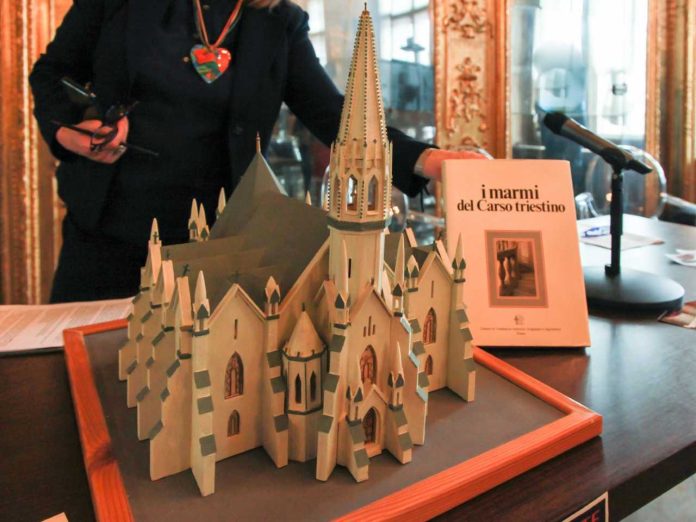by InTrieste
In a celebration of cultural heritage and architectural marvels, the Palazzo Economo hosts an extensive exhibition titled “From Ljubljana to Trieste, the Stone of Aurisina, Karst, and Istria in Italy and the World.” Representing one of the most comprehensive showcases dedicated to the Stone of Aurisina, Karst, and Istria, this exhibition promises a deep dive into the history and architectural significance of these stones.
Scheduled to open its doors on May 18, 2024, at 6:00 PM at Warehouse 26, the exhibition will be accessible to visitors from May 19 to July 14, with free admission.
This material journey through the culture of stone aims to provide visitors with insights into its historical significance, architectural applications, and artistic expressions. Guided tours, excursions, cultural insights, workshops, and performances complement the exhibition, enriching the visitor experience.
The exhibition, curated across multiple sections within the two pavilions, notably the Nathan and Sbisà halls of Warehouse 26, begins by delving into the entrepreneurial history and life of Gustav Tönnies. Born in 1814 in Stralsund, Pomerania, Gustav Tönnies emerged as a prominent figure in the Carniola region during the latter half of the 19th century. His ventures traversed countries like Sweden, Norway, France, Switzerland, and Russia before settling in Austria-Hungary. Tönnies’ contributions to the economic landscape of the region, particularly through the construction of the Southern Railway from Vienna to Trieste, underscore his pivotal role in European history.
Central to the exhibition’s narrative is the presentation of Karst and Istrian stones, pivotal in the economic and social development of the region. Of significant importance was the construction of the Vienna-Trieste Southern Railway, which transformed Trieste into a bustling Mediterranean port, facilitating trade routes from Northern and Central Europe to the Far East and the Americas.
The exhibition pays homage to Gustav Tönnies, whose legacy epitomizes the industrious spirit of the 19th-century Slovenian territory. From his architectural contributions to iconic landmarks like the Opera Theater and the Court Palace in Lubiana to the construction of warehouses and railway stations in Trieste, Tönnies’ imprint on the region’s landscape remains indelible.
Exploring the exhibition’s thematic pathways, visitors traverse a visual narrative from the Tönnies family’s endeavors in Lubiana to the grandeur of Trieste’s architectural gems. Noteworthy stops along the journey include landmarks like Palazzo Carciotti, Palazzo Ras, Teatro Verdi, and the Miramare Castle, among others.
Beyond the visual spectacle, the exhibition presents meticulously crafted wooden models of Trieste’s landmarks by Umberto Radivo, commemorating the city’s architectural heritage. These models serve as testaments to the intricate artistry and historical significance of the region’s stonework.
A focal point of the exhibition lies in showcasing the global impact of Aurisina stone, highlighting its enduring quality and timeless appeal. From architectural marvels in Italy to landmarks in Budapest, Paris, Atlanta, and beyond, the exhibition underscores the stone’s ubiquitous presence in ornamental design.
Complementing the visual narrative are displays dedicated to the artisans and craftsmen who have shaped the narrative of marble and stone in the region. Through panels highlighting local businesses, workshops, and historical documentation, visitors gain insights into the rich artisanal tradition intertwined with the region’s geological heritage.
As the exhibition unfolds, visitors are invited to delve into the historical resonance of stone, particularly its role in memorializing significant events like the World Wars. From monuments to trenches, the exhibition sheds light on the poignant use of stone in preserving collective memory.
In a collaborative effort with local stakeholders, the exhibition extends beyond the confines of Warehouse 26 to engage with territorial realities. Projects like the Kave Project and Carso Crea(t)tivo underscore the synergistic relationship between cultural promotion and community development.
Guided excursions and thematic meetings further enrich the visitor experience, offering immersive insights into the region’s historical and archaeological treasures. From the palaces of Trieste to the caves of Aurisina, visitors embark on a journey through history, traversing ancient ruins and architectural wonders.
As the exhibition resonates with the spirit of cultural exchange, plans are underway to extend its reach to international audiences. With the support of the Kathleen Foreman Casali Charitable Foundation, the exhibition is slated for a future showcase in Ljubljana, fostering cross-cultural dialogue and commemorating the enduring legacy of Gustav Tönnies and his works.





























